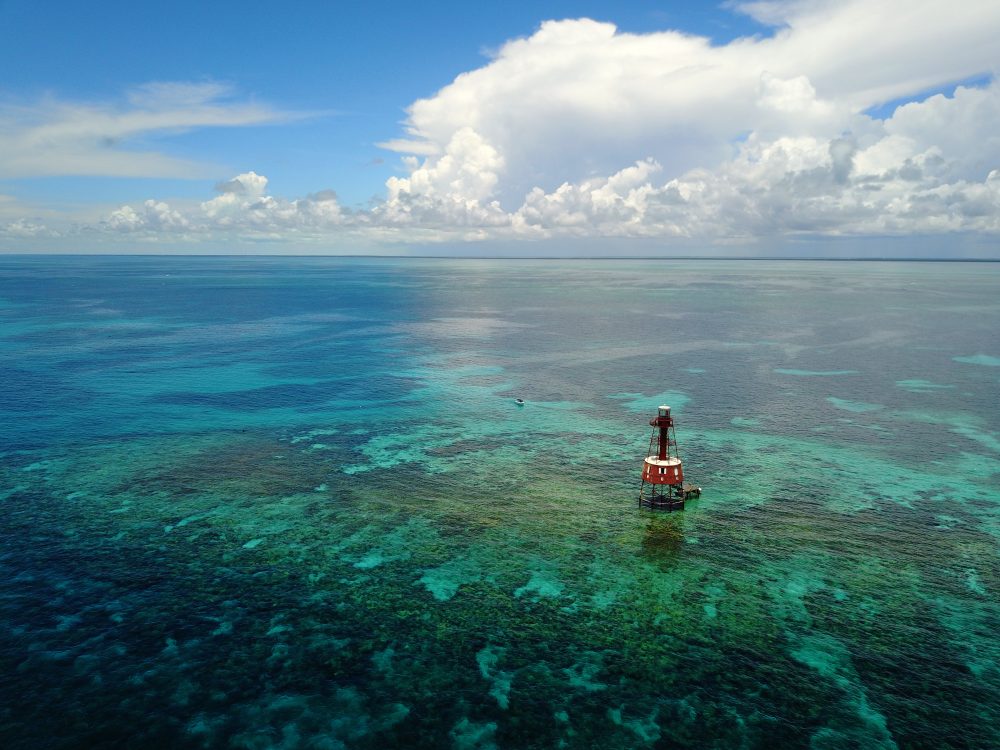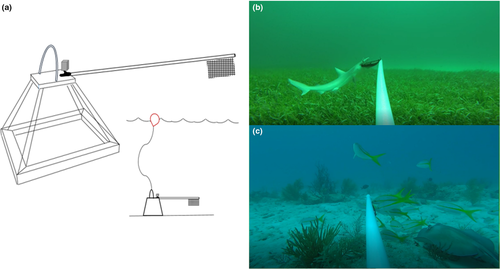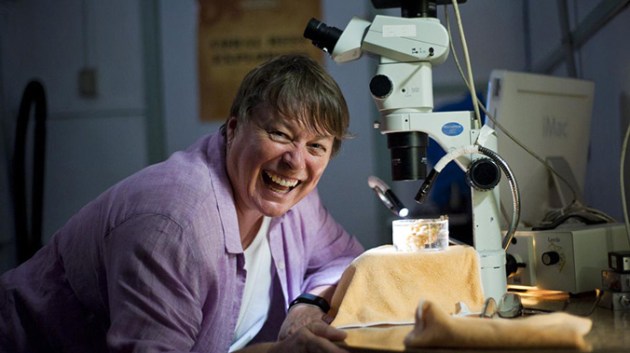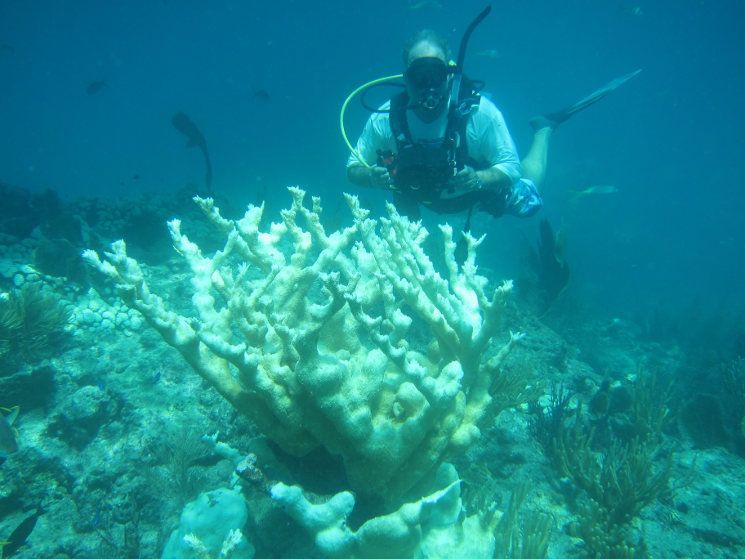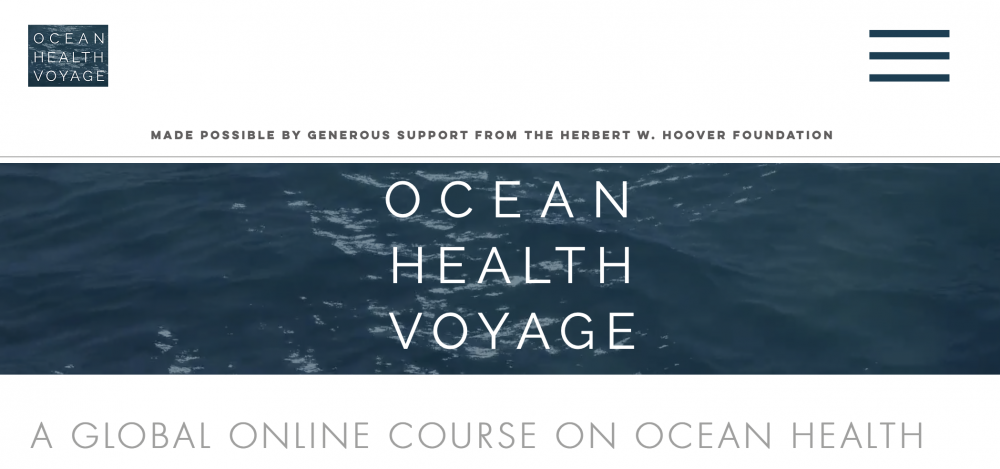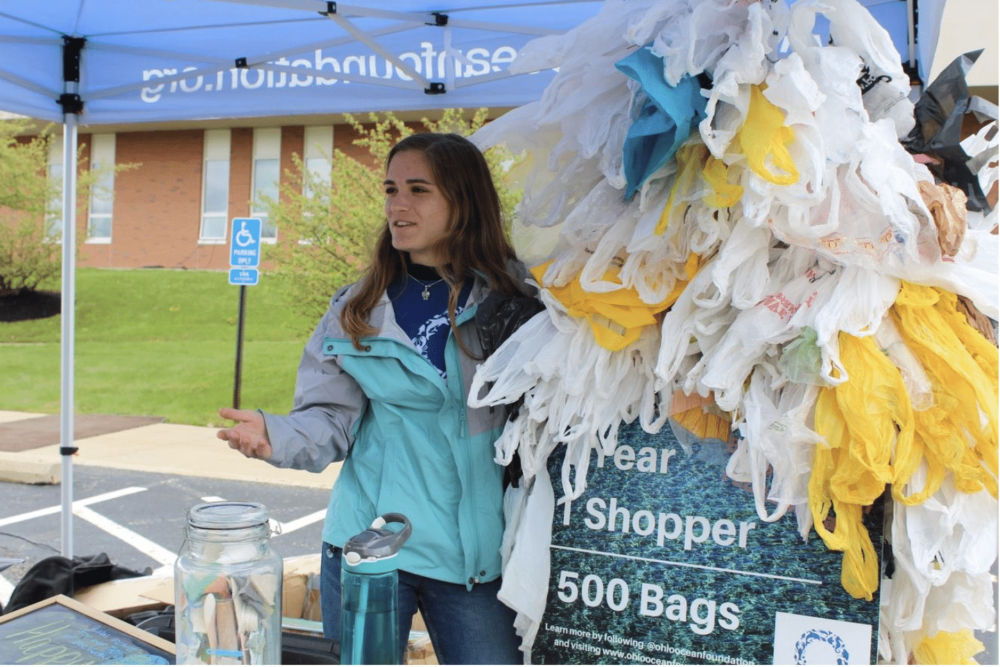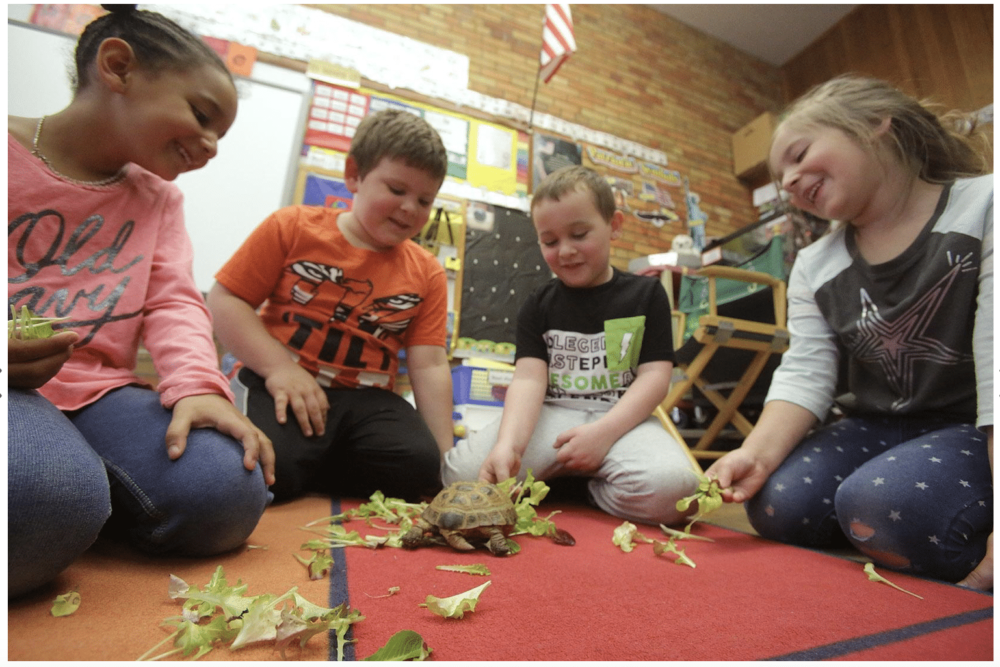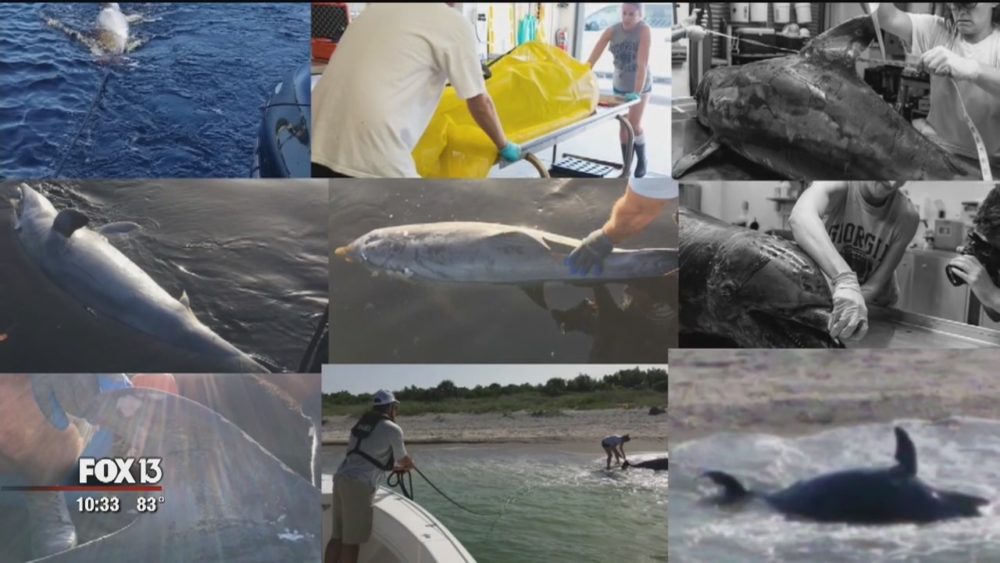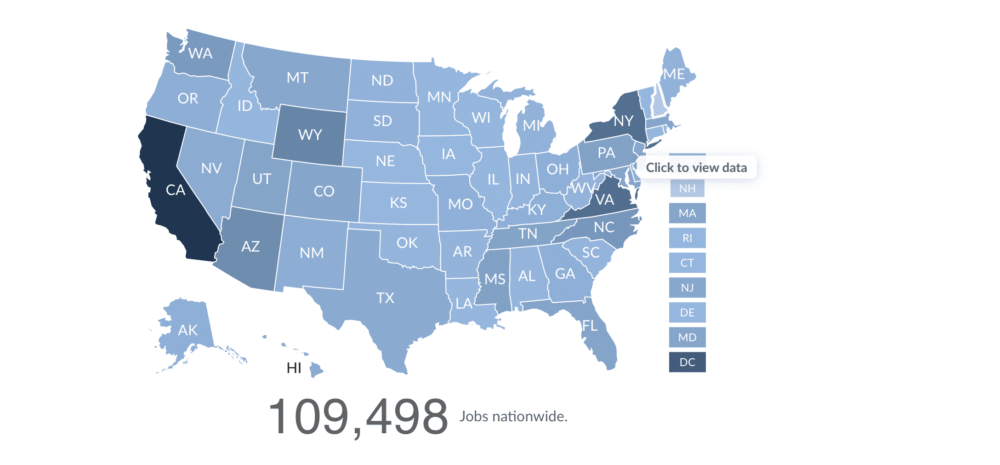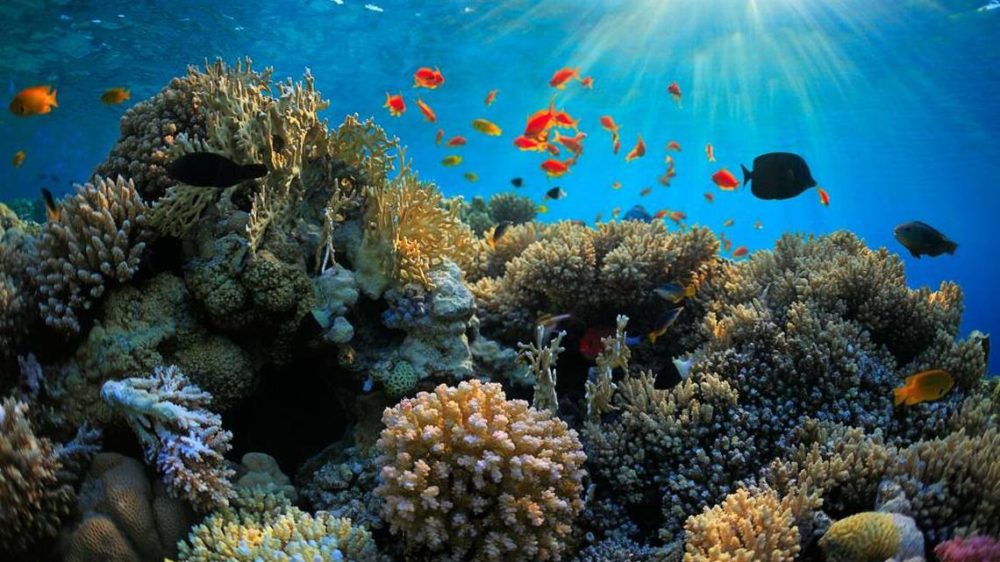Research Funded by HWH Foundation Published in Ecology and Evolution Journal
Originally published by Ecology and Evolution. Original article available here.
Evaluating the effects of large marine predators on mobile prey behavior across subtropical reef ecosystems
Lindsay M. PhenixDana TricaricoEnrique QuinteroMark E. Bond… See all authors First published: 28 November 2019 https://doi.org/10.1002/ece3.5784
Abstract
The indirect effect of predators on prey behavior, recruitment, and spatial relationships continues to attract considerable attention. However, top predators like sharks or large, mobile teleosts, which can have substantial top–down effects in ecosystems, are often difficult to study due to their large size and mobility. This has created a knowledge gap in understanding how they affect their prey through nonconsumptive effects. Here, we investigated how different functional groups of predators affected potential prey fish populations across various habitats within Biscayne Bay, FL. Using baited remote underwater videos (BRUVs), we quantified predator abundance and activity as a rough proxy for predation risk and analyzed key prey behaviors across coral reef, sea fan, seagrass, and sandy habitats. Both predator abundance and prey arrival times to the bait were strongly influenced by habitat type, with open homogenous habitats receiving faster arrival times by prey. Other prey behaviors, such as residency and risk‐associated behaviors, were potentially driven by predator interaction. Our data suggest that small predators across functional groups do not have large controlling effects on prey behavior or stress responses over short temporal scales; however, habitats where predators are more unpredictable in their occurrence (i.e., open areas) may trigger risk‐associated behaviors such as avoidance and vigilance. Our data shed new light on the importance of habitat and context for understanding how marine predators may influence prey behaviors in marine ecosystems.
1 INTRODUCTION
Top predators are characterized by some of the largest, most enigmatic, and threatened species today on Earth (Hammerschlag & Gallagher, 2017). Often occupying upper trophic tiers, predators can influence prey directly through consumption and also indirectly via the perceived risk of predation. These nonconsumptive effects can drive food‐risk trade‐offs that alter behavior, physiology, and foraging strategies in potential prey (Beauchamp, Wahl, & Johnson, 2007; Heithaus, Frid, Wirsing, & Worm, 2008; Rasher, Hoey, & Hay, 2017). In doing so, predators drive important ecosystem processes that may induce cascading effects throughout entire ecosystems (Estes et al., 2011). Despite the important roles they play in ecosystem dynamics, many populations of large predators are declining rapidly as a result of overexploitation, and habitat loss, among a myriad of other threats (Lennox, Gallagher, Ritchie, & Cooke, 2018).
While effects of apex predators are relatively well studied in terrestrial ecosystems (e.g., Suraci, Clinchy, Dill, Roberts, & Zanette, 2016), their roles in marine systems are generally less understood (e.g., Casey et al., 2017; Sandin et al., 2008). Sharks, for instance, are traditionally considered the de facto top predator in marine ecosystems, and their vulnerabilities to fishing (Gallagher, Kyne, & Hammerschlag, 2012) and general patterns of population decline (e.g., Ferretti, Worm, Britten, Heithaus, & Lotze, 2010) have reinforced the importance of understanding the implications of their removals on marine ecosystems. Often uniformly characterized as apex predators due to their size and trophic position in marine food webs (Heupel, Knip, Simpfendorfer, & Dulvy, 2014; Hussey et al., 2014), sharks may exert strong controlling influences on prey through behaviorally‐mediated, nonconsumptive processes (i.e., predation risk) (Heithaus et al., 2008; Heithaus, Wirsing, Burkholder, Thomson, & Dill, 2009). However, the degree to which sharks actually influence the behavior and physiology of prey species remains understudied and controversial (Casey et al., 2017; Roff et al., 2016; Ruppert, Travers, Smith, Fortin, & Meekan, 2013). Studies have suggested that on coral reefs, herbivorous fish reduce their feeding rates when exposed to a larger, stationary shark decoy (Catano, Barton, Boswell, & Burkepile, 2017; Madin, Gaines, & Warner, 2010; Rizzari, Frisch, Hoey, & McCormick, 2014), but it is unknown whether this acute suppression actually triggers a long‐term reduction in feeding or if it simply redistributes the prey fish to a different area. Similarly, it remains unknown how other sympatric marine teleost predators, such as barracudas (family Sphyraenidae) or morays (family Muraenidae), compare to sharks with regard to their nonconsumptive effects on prey. Nonconsumptive effects would be expected to be particularly prevalent in shallow, open ecosystems where a larger prey item’s opportunity for escape from roving, apex predators are limited (Heithaus et al., 2009), thus suggesting a potential effect of habitat complexity.
The lack of a generalizable predator effect (consistency in direction and strength) may be expected in diverse, three‐dimensional ecosystems such as coral reefs where water is clear and opportunities to shelter temporarily are extensive. These habitats provide increased visibility for and detectability of mobile, roving predators. Studies have suggested that in coral reef food webs, reef‐associated sharks and large teleosts occupy similar trophic niches (Bond et al., 2018; Frisch et al., 2016; Roff et al., 2016), which may allow for the detection of generalizable effects of predators on prey or may divert or dilute the nonconsumptive effects of species traditionally considered apex predators on larger prey species. Our knowledge of nonconsumptive effects of marine predators on prey may benefit from examining predator–prey interactions under varying environmental conditions.
An increasingly popular technique for noninvasively assessing the relative abundance and behavior of mobile fish populations, while removing diver bias, is baited remote underwater video (BRUV) surveys (Whitmarsh, Fairweather, & Huveneers, 2017). BRUVs consist of an underwater camera focused on a standardized bait source positioned in the field of view (FOV), with the unit orientated down current from the camera. Individuals attracted to the bait that swim into the FOV are “captured” on camera (Armstrong, Bagley, & Priede, 1992), providing a permanent record of observations that can be reviewed multiple times. This record improves the accuracy of the data and allows for detailed analyses such as those required for examining animal behavior. They have also been used in studies assessing predator–prey relationships (e.g., Klages, Broad, Kelaher, & Davis, 2014) and could be readily used to investigate the potential effects of marine predators on a suite of prey species, across a variety of habitats and conditions.
Here, we used BRUVs to examine the nonconsumptive effects of multiple marine predators on various mobile prey species, across the varying habitats of Biscayne Bay, Florida. We evaluated these predator–prey interactions in three ways: (a) inferring ambient risk in each habitat by quantifying relative predator abundance and foraging activity; (b) assessing habitat‐specific responses of potential prey species by measuring prey arrival (as a proxy for apprehensiveness); and (c) gauging risk‐associated behaviors of prey as well as prey residency at the bait stations (Bond et al., 2019). We hypothesized that (a) predator activity would be greater in complex habitats (Bruno, Stachowicz, & Bertness, 2003; Hutchinson, 1957); (b) prey would take longer to arrive in less complex, more open habitats due to limited shelter opportunities; (c) prey residencies would increase and the number of risk‐associated behaviors would decrease in more complex habitats (Bruno et al., 2003).
2 METHODS
2.1 Study site
This study was conducted from January 21 to August 31, 2017 in the waters of Biscayne Bay, Florida, USA, including within the boundaries of Biscayne National Park (BNP; 25°45′42.05″N, 80°11′30.44″W; Figure 1). This area extends from Key Biscayne to Key Largo and connects to the Florida Reef Tract, the third largest coral reef system worldwide. The area is defined by a mixture of coral reefs, seagrass beds, soft corals, and sand flats. Biscayne Bay is a shallow water lagoon in which a variety of habitats provide important functional, ontogenetic, and trophic value for mangrove and reef‐associated fish, including sharks and rays, as well as sea turtles and marine mammals (Serafy, Valle, Faunce, & Luo, 2007).

2.2 Baited Remove Underwater Video (BRUV) surveys
Predator–prey interactions among and between mobile elasmobranch and teleost communities were assessed throughout Biscayne Bay and Biscayne National Park using baited remote underwater video (BRUV) surveys. Each BRUV consisted of a 48‐cm tall metal pyramid frame with the sides converging at a flat, square platform (Figure 2). Additional weights (two, 0.5 kg dive weights) were added to each BRUV frame to increase stability. Each BRUV was equipped with a 100‐cm PVC bait pole, with a mesh bait bag (150 mm × 200 mm) attached at the end (via zip ties) containing ~450 g of freshly minced Spanish sardines (Sardinella spp.). High‐definition action cameras (GoPro Hero and Hero+) were secured to the square platform and positioned to face outward, with the bait bag within the estimated 160° FOV, all lights and flashing sensors on the cameras were deactivated. All footage was shot at 1,080p high‐definition at 30 frames per second.

All BRUVs were deployed from a boat and lowered to the sea floor via 30‐m ropes attached to a visible surface buoy. Deployment depths ranged from 1.3 m to 12.8 m with an average depth of 6.7 m. In‐water free‐divers were occasionally used to navigate the BRUVs away from living corals and to ensure proper orientation on the benthic substrate. BRUVs were deployed in contiguous areas in groups of three to five, spaced ~300–500 m apart, and were allowed to soak for 60 min. Deployments were focused in the following habitat types: coral reef (defined by the presence of coral colonies and structures), sea fan (defined by the presence of patchy sea fans), seagrass (defined by contiguous areas dominated by seagrass), and sand (defined by low‐rugose habitats with open sandy areas). Deployments occurred during daylight hours, between 0800 and 1330 hr. During each round of BRUV deployments, we measured depth and water temperature (°C) using a HANNA handheld probe (Hanna Instruments, HI 98193). Temperature was recorded as a control to account for any possible anomalies; average water temperature was 24.4°C across seasons. We characterized the habitat type as coral reef, sand, sea fan, or seagrass (based on 50% coverage or higher) and whether the site was inside or outside the boundaries of Biscayne National Park (a national park with varying fishing regulations, though it is not a no‐take zone nor a marine reserve).
2.3 Video analysis and variables considered
Each 60‐min video was reviewed and analyzed in real time. Analysis began once the BRUV was firmly planted in the benthos (~15–30 s) after deployment. Predators were categorized into three trophic tiers. Upper trophic predators included barracudas (Sphyraena barracuda), as well as large bodied (>2 m) mid‐water feeding sharks. Large bodied mid‐trophic predators included large benthic feeding sharks and green moray eels (Gymnothorax funebris), while small bodied mid‐trophic predators encompassed small bodied sharks (<2 m) and spotted moray eels (Gymnothorax moringa). Groupings were determined based on relative size and the presumed correlating trophic pressures they placed on the ecosystem (Bond et al., 2018; LaymanWinemiller, Arrington, & Jepsen, 2005). Seven common prey families were identified and used to measure habitat risk and risk effects: filefish (family Monacanthidae), grunts (family Haemulidae), jacks (family Carangidae), porgies (family Sparidae), rays (family Dasyatidae & Urotrygonidae), snappers (family Lutjanidae), and triggerfish (family Balistidae). These prey families were chosen due to their observed abundance in the surveyed habitats, and since they reflect a range of consumed prey items for members of the trophic levels listed above. For example, barracuda are known to be important predators of the selected families in our study region (Hansen, 2015). Large shark species found in Biscayne Bay and Florida Bay, such as blacktip (Carcharhinus limbatus), bull (Carcharhinus leucas), great hammerhead (Sphyrna mokarran), and lemon sharks (Negaprion brevirostris), retain higher trophic positions than many of the prey families and are known fish predators (Gallagher, Shiffman, Byrnes, Hammerschlag‐Peyer, & Hammerschlag, 2017; Hammerschlag, Luo, Irschick, & Ault, 2012; Matich, Heithaus, & Layman, 2011; Roemer, Gallagher, & Hammerschlag, 2016). Bonnetheads (Sphyrna turbo) and Atlantic sharpnose (Rhizoprionodon terraenovae) sharks may have varying feeding patterns, but are primarily inshore feeders with diets consisting of teleosts, crustaceans, and cephalopods (Plumlee & Wells, 2016). Similarly, grunts, jacks, and snapper have been found inside the stomachs of nurse sharks in Florida (Castro, 2000). While there is limited data on moray eel diet in our study area, work from other Caribbean areas suggests that they are piscivorous and readily consume snappers or grunts (Randall, 1967; Young & Winn, 2003).
The relative risk of each habitat where a BRUV was deployed was estimated using two predator‐focused variables: (a) predator abundance (maxNb and maxN) and (b) predator foraging activity. Predator abundance was quantified for each trophic grouping (maxNb) by tallying the number of distinctly different individuals, determined by family, sex, size, and markings, observed throughout the entire video duration (Bond et al., 2012). Additionally, a combined predator abundance was taken from each BRUV in the form of maxN, which represents the maximum number of predators, regardless of grouping, present together at one time (Bond et al., 2012). We quantified predator foraging activity rates on the bait bags by recording the number of bites from predators and whether severe damage occurred to the bag (0 = no damage, 1 = severe damage). Bait bags were categorized as “severe damage” if the bag had major lacerations or rips, or if the bag was totally removed from the pole. Nonpredatory fish also have the potential to inflict damage to the bags (i.e., triggerfish), so any instances of damage to the bags from nonpredatory fishes (ascertained via video validation) that could have confounded the detectability of our bait were not included in these analyses.
Potential responses of prey species to ambient predation risk were estimated using arrival times for each prey family (as a proxy for apprehensiveness), as well as evaluating three prey‐focused behaviors (burst swimming, schooling, and bait residency). Arrival time (s) was measured by recording the total elapsed time until the first individual from each prey family arrived on camera. Burst swimming events (defined as a short, rapid swimming behavior away from the frame; Gallagher, Brandl, & Stier, 2016; Gallagher, Lawrence, Jain‐Schlaepfer, Wilson, & Cooke, 2016) and schooling events (defined as instances where groups of five or more conspecific individuals were present; Viscido, Parrish, & Grünbaum, 2005) were recorded for the previously defined prey groups. Bait residency (sec) was evaluated for each replicate as follows: the first fish, regardless of species, to make contact with the bait was monitored until it had moved an estimated three or more body lengths distance from the bait bag (Bond et al., 2019).
2.4 Statistical analyses
Because data violated assumptions of normality and homogeneity of variance (confirmed using Shapiro–Wilk’s and Levene’s tests), we performed a zero‐inflated generalized linear model (GLM) with a negative binomial error distribution and a log‐link function to assess the ambient risk of each habitat, with habitat type and its interaction with predator functional groups specified as the independent variables and predator maxNb as the response variable. Similarly, we performed a GLM with a negative binomial error distribution on prey arrival times, with the response variable being the arrival time of prey species and the independent variables being habitat type, predator maxN, and their interaction. Instances where an individual from a prey family did not appear on the BRUV footage (i.e., not arriving) were excluded from the model. Because this resulted in low replicates for some prey fish species (e.g., rays), we did not specify prey species as an independent variable and assumed that effects of predators are generalized across all prey species. For both GLMs, we used the obtained parameters for predictions and then plotted the predicted values against the raw data to visualize both the obtained patterns and the model fit.
Predator foraging activity and prey behaviors were then visualized using a nonmetric multidimensional scaling ordination (nMDS) based on a Manhattan distance. Furthermore, a PERMANOVA was run on the same distance matrix in order to determine if habitat type, predator maximum abundance, or their interaction affected prey behavior. Finally, we analyzed correlations between predator foraging and prey risk‐associated behaviors for each habitat using a set of Spearman rank correlation analyses. All statistical analyses were performed using R Studio (R Core Team).
3 RESULTS
A total of 194 deployments were made, within a total survey area of ~15 km2. Of these, 37 deployments were discarded due to the BRUV tipping over in heavy current or poor visibility, leaving a total of 157 videos (n = 157) that were used in analyses (Table 1). A total of 184 predators were recorded by the BRUVs throughout the sampling period (Table 2). Of those predators, 80 individual elasmobranchs from eight species (7 shark species, 1 ray species) were recorded, in addition to 88 barracuda and 16 moray eels. There were limited seasonal differences in maximum predator abundances (maxN) and prey arrival times across habitats, except for seagrass beds, where maximum predator abundance was substantially higher in the wet season (0.690 ± 0.0.123 individuals, mean ± SE) than in the dry season (0.091 ± 0.063). In fact, no barracudas or large bodied mid‐trophic predators were observed in seagrass habitats during the dry seasons. However, prey arrival times in seagrass beds did not differ between the two seasons.Table 1. BRUV deployments by season and habitat type
| Habitat | Season | |
|---|---|---|
| Dry (January–April) | Wet (May–December) | |
| Coral reef | 4 | 15 |
| Sea fan | 9 | 34 |
| Seagrass | 22 | 30 |
| Sand | 16 | 27 |
Table 2. Summary of predatory species observed on BRUVs in the present study
| Upper trophic | Large mid‐trophic | Small mid‐trophic | |||
|---|---|---|---|---|---|
| Barracuda (Sphyraena sp.) | 88 | Green Moray (Gymnothorax funebris) | 4 | Atlantic Sharpnose (Rhizoprionodon terraenovae) | 14 |
| Blacktip (Carcharhinus limbatus) | 3 | Nurse (Ginglymostoma cirratum) | 22 | Blacknose (Carcharhinus acronotus) | 3 |
| Bull (Carcharhinus leucas) | 2 | Sawfish (Pristis pectinata) | 1 | Bonnethead (Sphyrna turbo) | 34 |
| Great Hammerhead (Sphyrna mokarran) | 1 | Spotted Moray (Gymnothorax moringa) | 12 | ||
| Total | 94 | 27 | 63 |
Predator abundances (maxNb) were significantly different among habitat types, with coral reefs having the highest average maximum number of predators per deployment (2.21 ± 2.04), followed by sea fan habitats, sand, and seagrass habitats (Table 3, Table 4). Predictions from the GLM further suggest an interaction effect between trophic level grouping and habitat. Coral reefs had the greatest mean abundance of upper trophic and large bodied mid‐trophic predators, whereas sea fan habitats had the greatest mean abundances of small bodied mid‐trophic predators (Figure 3). Prey arrival times were significantly influenced by the interactive effects of habitat and the cumulative maximum number of predators (maxN) (Table 5). Grunts, porgies, and snappers arrived comparatively early at the BRUV deployments, while stingrays arrived substantially later. The GLM revealed that the effect of maximum predator numbers in sand, sea fan, and seagrass habitats are negative and significantly different from effects of predators on coral reefs, where cumulative predator maximum number and prey arrival time were positively correlated. This is further supported by the predictions from the model, which show a steep negative relationship in sand and seagrass habitats, a nearly flat but slightly negative relationship in sea fan habitats and a positive relationship for coral reefs (Figure 4).Table 3. Mean predator abundance per BRUV deployment across the four habitat types (coral reef, sand, sea fan, and seagrass), decomposed into the different trophic levels and their combined abundance (MaxNb)
| Upper trophic | Large mid‐trophic | Small mid‐trophic | Max Nb | |
|---|---|---|---|---|
| Coral reef | 1.16 (±0.384) | 0.474 (±0.140) | 0.579 (±0.318) | 2.21 (±2.04) |
| Sand | 0.674 (±0.169) | 0.093 (±0.045) | 0.140 (±0.053) | 0.907 (±1.231) |
| Sea fan | 0.581 (±0.245) | 0.256 (±0.067) | 0.721 (±0.206) | 1.56 (±1.94) |
| Seagrass | 0.346 (±0.095) | 0.058 (±0.033) | 0.288 (±0.092) | 0.692 (±1.15) |
Table 4. Summary results from a zero‐inflated negative binomial generalized linear model used to test the effects of habitat type on predator abundance (maxNb) by trophic level
| Coefficients | Estimate | SE | Z value | Pr(>|z|) | |
|---|---|---|---|---|---|
| Intercept (coral reef:large mid‐trophic) | −9.041 | 0.43 | −21.03 | *** | |
| Sand | −1.598 | 0.685 | −2.33 | * | |
| Sea fan | −0.659 | 0.555 | −1.19 | ns | |
| Seagrass | −2.137 | 0.739 | −2.89 | ** | |
| CR | Upper trophic | 0.886 | 0.551 | 1.61 | ns |
| Small mid‐trophic | 0.252 | 0.591 | 0.43 | ns | |
| SD | Upper trophic | 1.993 | 0.594 | 3.35 | *** |
| Small mid‐trophic | 0.435 | 0.697 | 0.62 | ns | |
| SF | Upper trophic | 0.82 | 0.443 | 1.85 | . |
| Small mid‐trophic | 1.016 | 0.434 | 2.34 | * | |
| SG | Upper trophic | 1.766 | 0.667 | 2.65 | ** |
| Small mid‐trophic | 1.594 | 0.675 | 2.36 | * |
Note
- Significant codes: ‘***’ 0.001 ‘**’ 0.01 ‘*’ 0.05 ‘.’ 0.1.

Table 5. Summary results of a negative binomial generalized linear model of the effects of habitat type on maximum combined predator abundance (maxN)
| Coefficients | Estimate | SE | Z value | Pr (>|z|) |
|---|---|---|---|---|
| Intercept (coral reef) | 5.865 | 0.156 | 37.6 | *** |
| Sand | 1.331 | 0.172 | 7.73 | *** |
| Sea fan | 0.463 | 0.174 | 2.66 | ** |
| Seagrass | 1.035 | 0.168 | 6.18 | *** |
| maxN | 0.167 | 0.100 | 1.67 | ns |
| Sand: maxN | −0.601 | 0.141 | −4.26 | *** |
| Sea fan: maxN | −0.247 | 0.114 | −2.17 | * |
| Seagrass: maxN | −0.366 | 0.130 | −2.82 | ** |

The nMDS ordination of both predator foraging activity (i.e., number of bites) and prey behavior in response to habitat type showed little variation among habitats (Figure 5). Generalized predator foraging activity was not significantly influenced by any habitat type, although BRUVs deployed on coral reefs experienced the highest average number of predatory bites (2.211 ± 3.441 bites, mean ± SE) and instances of severe damage to the bait bag (0.263 ± 0.452 instances, mean ± SE). Prey burst swimming (4.579 ± 7.932 events) and schooling events (6.053 ± 4.801 events) also had the highest average occurrences on coral reefs when compared to sand, sea fans, and seagrass habitats (Table 6). Average prey residency at the bait was the greatest in sea fan habitats (32.211 ± 32.527 s). The PERMANOVA to test the explanatory power of habitat, predator maximum number, and their interaction on different behaviors, albeit revealing a significant habitat effect (p = .001), only explained ~10% of the variation in the data and no effect of predator maximum number or its interaction with habitat was observed. The Spearman rank correlation test showed significant correlations between predator and prey behaviors in sand, seagrass, and sea fan habitats, but not on coral reefs (Figure 6). Schooling behavior was the only one to show a positive relationship with predator maximum numbers across sand, seagrass, and sea fan habitats.

Table 6. Mean predator foraging activity (bites and severe damage) and prey response behavior (burst swimming, schooling, and residency) across four habitat types
| Predator bites | Severe damage | Burst swimming | Schooling | Prey residency | |
|---|---|---|---|---|---|
| Coral reef | 2.211 (±3.441) | 0.263 (±0.452) | 4.579 (±7.324) | 6.052 (±4.801) | 24.316 (±18.973) |
| Sand | 0.791 (±1.684) | 0.070 (±0.259) | 0.698 (±3.377) | 1.395 (±2.555) | 8.814 (±17.14) |
| Sea fan | 1.558 (±4.078) | 0.136 (±0.351) | 1.605 (±3.13) | 4.628 (±4.232) | 32.211 (±32.527) |
| Seagrass | 0.865 (±2.360) | 0.096 (±0.298) | 0.745 (±1.741) | 2.980 (±3.906) | 20.192 (±27.652) |

4 DISCUSSION
Predator–prey interactions can structure marine habitats by actively changing habitat use, foraging behaviors, and food‐web dynamics (Morosinotto, Thomson, & Korpimäki, 2010). We predicted that prey fishes would be more apprehensive and thus arrive later in the field of view of the BRUV in habitats with increased predator abundance and vice versa in those with fewer predators. Our results suggest that this pattern held true only for coral reefs, where predator numbers appeared to have a negative effect on prey arrival, while in all other habitats, the two variables were positively correlated. While coral reefs offer increased structural complexity and refuge for prey, they also increase potential predation risk by obscuring prey fish’s field of view (Bond et al., 2019). These components of the habitat may provide predators with a functional advantage when hunting, thereby creating a more dangerous environment and increasing prey vigilance in these areas. Thus, the interaction between habitat features and the probability of predator detection and successful escape can result in altered prey risk‐associated behaviors and vigilance (Heithaus et al., 2009). It has been recently argued that predators may exact greater influences on prey behavior where predation risk is predictable (Creel, 2018). While we did not measure predictability of predation risk in our study, abundance of predators in certain habitats, a potential proxy for exposure, may have resulted in a pro‐active response of apprehensiveness toward the bait, although this remains speculative.
Predators are known to match prey distributions on small scales when prey is abundant (Heithaus & Dill, 2006), and, as observed in the present study, coral reefs generally contain high numbers of piscivores (Hixon & Beets, 1993), which can inversely affect prey abundance on reefs (Beukers‐Stewart, Beukers‐Stewart, & Jones, 2011). On average, grunts and snappers arrived on coral reefs and in sea fans long before any predators. Whether predation risk is “predictable” or chronic on coral reefs remains unknown, but our findings offer an interesting potential link to the predicted food‐risk effects as described in the “control of risk” hypothesis (Creel, 2018).
Animals often express their antipredator‐behaviors in high risk situations that are brief and infrequent (Lima & Bednekoff, 1999). These acute “reactive” responses are linked to areas of unpredictable predation risk (Creel, 2018). We hypothesized that potential behavioral risk effects might be highest in open areas. Interestingly, we observed faster prey arrival times in more open, homogenous habitats such as sea fans, sandy areas, and seagrass. The lack of resources in these open, plain habitats may have rendered our BRUVs a more attractive source of food, resulting in both prey and predators arriving sooner; in our study, we found that grunts and snappers were much quicker to arrive to a habitat where predators were more abundant (Nagelkerken & Velde, 2004). It is also possible that these open and homogenous habitats provide increased escape routes to prey if needed, thus making them worth the “risk.” Additionally, since predators are often transient in these habitats (Hammerschlag, Morgan, & Serafy, 2010), attacks may be less predictable. Therefore, our observed patterns for behavioral effects in these habitats may stem from a combination of resource provisioning and unpredictability of predation risk.
In general, juvenile and small bodied sharks (i.e., small mid‐trophic predators) can be found in shallow waters to minimize their own predation risk (Guttridge et al., 2012; Heupel et al., 2014). More than half of the sharks captured on the BRUVs were species that reach maximum sizes of <2 m. While it stands to reason that smaller predators induce a weaker response in prey than larger conspecifics or species (due to gape limitations), smaller mesopredators (hawkfish, Parrachirrhites arcatus) have been found to have equal nonconsumptive effects compared to larger conspecifics (Gallagher, Brandl, et al., 2016; Gallagher, Lawrence, et al., 2016). Most predators (regardless of trophic grouping) in our videos did not stay for prolonged periods of time and, as such, they represent an acute, but relatively inconsistent, pulsed source of predation risk. Finally, some small species (e.g., bonnetheads) may also have limited effects on prey because both juveniles and adults primarily feed on crabs, lobsters, and cephalopods (Bethea et al., 2007).
The extrapolation of our results beyond our study design is hindered by several caveats. Firstly, we do not know whether arrival times are truly a consequence of perceived predation risk or if they are a function of varying densities of individuals which could not be controlled. We also did not measure water currents at each of our BRUV stations, which could have affected the bait dispersal at different rates, thus changing detection potential by prey species. Furthermore, our statistical power was weakened by poor visibility (resulting in the exclusion of 37 replicates) and a category 5 hurricane, which ended data collection a bit early and thus prevented extended sampling. In future studies, dusk or night time deployments should be added to observe predator–prey interactions after dark, which may be especially important for sharks on coral reefs (Hammerschlag et al., 2017).
The role of “apex”‐predators on reefs has been brought into question in recent years (see Roff et al., 2016). While we caution overextending the results of this study to other regions, our data suggest that predators regardless of their trophic position do not significantly control mobile prey behavior on short temporal scales, across habitats. Instead, a habitat‐specific response to a consistent signal of mobile predators on reefs may result in proactive prey vigilance and subtle food‐risk trade‐offs. Specifically, less complex habitats where predators are known to patrol yet remain temporally unpredictable in their occurrence due to limited numbers and potentially wider activity areas may induce different reactive behavioral effects such as schooling and burst swimming, which, when extended over larger time scales, could have metabolic and fitness‐level impacts on prey. Taken together, these results suggest that context is important when trying to disentangle the effects of top predators on prey in costal marine habitats, and future studies should examine the interactions between mobile predators and habitat in order to link predation risk theory to observations.
ACKNOWLEDGMENTS
This work was supported by funding to Beneath the Waves from the Herbert W. Hoover Foundation, as well as from C. and M. Jones. We are grateful to M. Riera, E. Pritchard, C. Perry, R. Tricarico, Shake‐A‐Leg, and the International Seakeepers Society for their assistance with this project. This work was conducted under a Biscayne National Park permit BISC‐00076 to AJG.
CONFLICT OF INTEREST
The authors declare no competing interests.
AUTHOR CONTRIBUTIONS
A. J. G., M. E. B., and S. J. B. conceived and designed the study. L. M. P., D. T., E. Q., and A. J. G. conduced the field work. L. M. P. and S. J. B. performed the analyses. All authors contributed to writing the manuscript and gave approval.
Gates’ passion lives on through interactive coral documentary
Originally published by the University of Hawaii News. Original article available here. The Herbert W. Hoover Foundation is proud to have supported the creation of this interactive documentary.
The late Ruth Gates’ amazing contributions to science, communication and coral research come together in a new interactive documentary Lost Cities. Gates passed away October 25, 2018 while serving as director and researcher at the Hawaiʻi Institute of Marine Biology at the University of Hawaiʻiat Mānoa. The online documentary reveals the hidden lives of corals, and Gates’ voice completely transforms the experience.
“The loss of such a brilliant scientific mind and wonderful human being is made more bearable by this posthumous gift,” said UH Mānoa Provost Michael Bruno. “Lost Cities delights and educates at the same time and it is great to be able to hear Ruth’s voice once again.”
- Related UH News story and video: In memoriam: Ruth Gates, coral reef conservation trailblazer, October 29, 2018

Ruth Gates (Photo credit: Elyse Butler)
From the stunning, rarely-seen inner world of a single coral to massive reef structures visible from space, the story takes viewers underwater and into the lab to explore corals and their connections to us.

Unlike a film viewed in a theater, Lost Cities uses the web to create an interactive experience. Viewers can move through 13 short films in the order they choose, and access entry points to dive deeper into the themes through additional clips and photographs.
The project is a collaboration between the Gates Coral Lab, CaravanLab and Belle & Wissell Co. It contains the last recorded interview with Gates, a powerful and visionary voice for corals.
“Ruth was so passionate about corals that she wanted the rest of the world to experience how magnificent they are, and that is exactly what Lost Citiesoffers. We felt launching today would encourage everyone to reflect on her amazing contributions to research, science communications, and, of course, corals,” said Gates Coral Lab Program Manager Kira Hughes.
By exploring what lies beneath the surface, Lost Cities brings to light the surprising ways the lives of corals are interwoven with our own.
Sharing Lost Cities
The project was funded by the Herbert W. Hoover Foundation, Pam Omidyar and Bill Price. The Gates Coral Lab is working with Kailua High School teachers and students to complete activities to go along with the interactive documentary so that schools across the world can actively participate in the experience.
The Phase II goal is to make Lost Cities available through an app and at kiosk stations in public spaces to reach those who otherwise wouldn’t have a chance to experience it. The collaborators are currently seeking funding for that phase.
More on Gates
Nutrient Runoff Starves Corals in the Florida Keys
Too much nitrogen killed off corals in the Keys, and, as reefs suffer around the world, this new research offers lessons learned in Florida that could save other nutrient-loaded corals
Originally published by Environmental Health News. Original article available here. The Herbert W. Hoover Foundation is proud to have supported the research described in this article.
Rising ocean temperatures, a consequence of climate change, are known for bleaching and killing corals. But a study, published today in Marine Biology, reveals another overlooked culprit: excess nitrogen.
Between 1984 and 2014, researchers from the Florida Atlantic University studied Looe Key, a reef off the Florida Keys. Three decades of data gave them an unprecedented look at the shifting quality of marine waters. Runoff from the Everglades caused increased levels of nitrogen and algae blooms, which were followed by outbreaks of coral disease, bleaching and death. The study suggests that eutrophication, the excess enrichment of nutrients, played a primary role in causing the coral reefs to decline at Looe Key.
These findings come as corals around the world are in dying. So far, more than a quarter of the planet’s reefs are gone. The destruction is most often attributed to ocean acidification and rising temperatures, both the result of climate change, however, the new research suggests there could be more at play in certain regions.

Brian LaPointe, the new study’s lead author, wondered about nutrient runoff—which comes from sewage, fertilizers and topsoil— when he moved to Florida in the early ’80s. The state population was increasing, and he speculated that more nutrients would be washing into the ocean as a result. Too much runoff causes algae blooms, which choke out sunlight and deplete oxygen for other species.
“We thought we should start a water monitoring program,” LaPointe told EHN.
Timing was important. When they began the study in 1984, water quality in the Keys was still “relatively good,” LaPointe said.
But starting in 1980, Florida invested in a plan to move freshwater from the north down to the Everglades, which are adjacent to the Florida Keys. Proponents thought Florida Bay needed more freshwater in order to prevent algae blooms.
“In fact, it was just the opposite: it was feeding the blooms,” LaPointe said. As freshwater flowed into Florida Bay, thousands of tons of nitrogen came with it. Between 1984 and 2014, LaPointe and other researchers documented three time periods when excess nitrogen triggered coral bleaching, disease and death.
In 1984, corals covered one third of the Looe Key Sanctuary Preservation Area. By 2008, they only covered 6 percent. The researchers saw a pattern: more corals died between 1985 to 1987, then again from 1996 to 1999, after heavy rains and when Florida implemented projects to move freshwater to the Everglades.
“We warned resource managers about the perils of sending water south, knowing it was going to increase nitrogen loading and algae blooms,” LaPointe said. “But we didn’t have all the information in detail about how the corals would get stressed.”

Corals normally thrive in low-nutrient waters. Excess nitrogen can throw an ecosystem out of whack. But it isn’t the sheer amount of nitrogen that disrupts corals: it’s actually the ratio of nitrogen to phosphorus. When that ratio increases, it starves corals of phosphorus.
In a lab setting, researchers have played with the ratio, demonstrating that it can make corals deficient in phosphorus. “But our study put it in an ecological context, showing how this story has played out three times in a row,” LaPointe said.
LaPointe also sees nutrient enrichment affecting corals on other reefs. At the Bonaire coral reefs in the Caribbean Netherlands, nearby hotels previously used septic tanks. Those reefs are finally beginning to recover, only after the island switched to a new wastewater treatment plant in 2011.
“It’s one of the first examples in the Caribbean where by improving the water quality, they have turned a dying reef into a recovering reef,” LaPointe said. “We need more examples of that.”
LaPointe sees these results as promising: Unlike the daunting task of curbing carbon emissions, communities can reduce nitrogen runoff at a local scale.
“There’s something we can do about this, and we’re already doing something about it in the Florida Keys,” LaPointe said. Improvements include updating sewer systems with better waste treatment. Using less fertilizer and treating stormwater could also help.
“But it’s going to take time. It took decades for this reef to die off. It’s not going to come back overnight.”
Incorporating High-Caliber Documentary Media
Originally published by Virtually Inspired. Original article available here. The Herbert W. Hoover Foundation is proud to have supported the University of Miami in the development of the Ocean Health Voyage global course.
Course modules taught from the field with cutting-edge research from top world marine scientists
Led by the School of Communication at the University of Miami, the Ocean Health Voyage project is herald as an innovative online teaching project that can change the impact of documentary filmmaking. With the goal to reach all majors, collaboration across schools within the university was imperative and what’s more, partnerships with other universities across the globe plays a major role.
The Rosenstiel School of Marine and Atmospheric Science at the University of Miami is one of the premier oceanographic research and education institutions in the world contributes to the success of this online course. Likewise, the School of Arts and Sciences, The Office of Hemispheric & Global Affairs and the Hemispheric Consortium consisting of fourteen universities across Latin America and Canada play important roles. It is the work and passion of a professor in the School of Communication, however, with the generous support of the Herbert W. Hoover Foundation that birthed this highly innovative course about the world’s ocean health.
Documentary Filmmaking as a Media for a Highly Innovative Online Course
Ali Habashi is an award-winning documentary filmmaker who has covered stories in more than 50 countries. His work has been featured in numerous publications such as USA Today and aired on international Cable and Public TV channels such as Discovery (US and India), Canal+(France), CZTV (Czech Republic), LAPTV (Latin America) and CNN Türk.
As Assistant Professor in the School of Communication at the University of Miami, Ali currently teaches courses in digital production at the Department of Cinema and Interactive Media as well as courses in science documentary film production for graduate students majoring in Public Health, Molecular Biology and Environmental Sciences.
Using his skills and passion, Ali is creating a unique approach in online learning by combining it with his unique skills set. Professor Habashi shares his insight stating, “When it comes to innovation education, …there (are) certain types of content that all of our students need to know, and we have to find new ways to reach them. So, when it comes to environmental issues and health issues, climate change, and things like that, we need to find ways to reach to all the students no matter if they’re from School of Engineering, School of Communication Arts and Sciences, or School of Education. They all need to have that education. So, part of that innovation is to create those sorts of courses where we can reach all of them. And I believe that one way to do that is to get some of the most distinguished scientists to go into the field and bring that experience for them and even design assignments so that students have a meaningful way of getting involved in these sorts of topics. That is the experience that we need to create beyond one university for all of our students.”
Putting much time and effort into producing a documentary without having significant impact can be frustrating to filmmakers, particularly those with a passion for their subject. Incorporating high-caliber documentary media into an online course to be experienced and retained by a much broader scope of students can be a turning point for documentary filmmakers. Not only does this bring tremendous value to their work, but most importantly, it can have the impact the work deserves by teaching critical thinking skills and cultivating the student’s perspective on current events.
Ali said it best, “My personal background is documentary film-making and I’ve been fortunate to work in about 50 countries. But at some point, you realize, when you spend that much effort, who is retaining it and especially in our time when we are bombarded with a ton of media. And when it comes to content that matters, environmental issues, health issues, we’ve got to find a way that is not entertainment anymore… it is a real education.”
Groundbreaking Online Specialty Course Offered
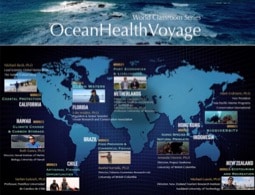
Oceans Health Voyage not only explains the science underlying the ten goals of ocean health Index but also brings the specific work of top researchers worldwide, from their field locations to university curricula. This groundbreaking introductory online course is produced professionally in ten international locations to help students in all disciplines learn and retain the core concepts of ocean health.
Thanks to the Herbert W. Hoover Foundation, Professor Habashi has been able to produce an innovative media-based online platform of the highest cinematic caliber to launch the first of many specialty courses. Colton Hoover Chase, explains “The Herbert W. Hoover was founded over 35 years ago by my grandfather Herbert W Hoover Jr. It was his vision that by funding high-class scientific endeavors and then educating the public about those endeavors the world and the public would make better decisions when it comes to interacting with the environment. The Ocean Health Voyage was really an intersection of our two focuses education and environment so when the opportunity presented itself, we jumped at the chance to fund such a great project.”
Ali was fortunate to not only procure funding for his work; the course also greatly benefitted from the insight and support the foundation was able to provide. Colton lent his network of connections and his experience to help saying, “Growing up around this foundation, I had the opportunity to really grow up around some of the world’s leading marine scientists. And it was almost a prerequisite for me to fall in love with the ocean. So, when it came time for me to pursue my education I inevitably went into environmental science.

When this project came around, it seems like a really great opportunity for me to leverage those relationships that had made me fall in love with the ocean and connect the world’s greatest scientists with the students of the world so that hopefully they too would have the opportunity to fall in love with the ocean in the same way that I did.”
In addition to bridging connections to expert marine scientists worldwide, Colton traveled with Ali to each location to film these subject matters experts while they were teaching from the field. These experiences were captured in a high-caliber documentary style video then layered modularly to build the course.
From above and under water, fundamental ocean science is taught while sharing the real-life complexities of working with stakeholders and finding solutions for balancing resource consumption and conservation.
Each module also provides a learning platform for the cutting-edge research of each scientist. Critical questions are analyzed through group discussions, student participate in innovative assignments and a capstone project and opportunities for further exploration of the topics that most interest students are shared through a wide variety of online resources.
Top Marine Scientists Teach Various Modules from Across the Globe

Having a well-informed background enables students to critically evaluate current events. The current status of our oceans worldwide is of important concern which leads many to believe that every undergraduate student should have a basic understanding of marine environments and conservation science.

Through a hemispheric consortium the presidents of 14 Pan American universities signed an agreement which includes, as one its educational initiatives, to offer this course for their students. Work is underway to prepare these universities for delivering Oceans Health Voyage.
Lourdes Dieck-Assad, Vice President for Hemispheric and Global Affairs at UM shares, “The Ocean Health Voyage course is a truly innovative platform which the University of Miami is employing to connect not only its own students to an international experience, but those of 14 universities from the Caribbean, Latin America and North America. We are in the process of deploying this unique course across our recently formed Hemispheric University Consortium, consisting of 14 universities in the hemisphere that are working together on problem-based collaborative learning. We are extremely excited about the potential that the Ocean Health Voyage has in terms of fostering global collaboration to address global challenges among students and professors across the Americas and Caribbean and look forward to the valuable knowledge it will impart on a new generation of learners .”
In his ongoing efforts to contribute to a global dialogue, Professor Habashi is planning to collectively create more courses like Ocean Health Voyage. The topic of the next one is “SMART CITIES”.
Kent State at Stark celebrates Earth Day with community event
Kent State University at Stark celebrated the earth and brought awareness to the environment during its 11th annual Earth Day event Sunday.
This story was originally published by The Independent. The original article is available here.
JACKSON TWP. Kent State University at Stark’s annual Earth Day celebration is another way the regional campus shows its dedication the environment.
Brielle Loughney, marketing assistant at Kent Stark and event coordinator, said families and community members were able to visit more than 60 exhibits to participate in activities and learn more about earth friendliness.
Two dozen of the exhibits were new to the event this year, she said, including an Akron Zoo animal presentation, Stark County Beekeeper’s Association and Ernie’s Bike Shop.
Rain held off Sunday afternoon and the sun peeked out from behind clouds to make for a chilly but dry outdoor event. Hundreds gathered at Kent Stark for the university’s 11th annual event celebrating Earth Day, which was last Monday.
The university considers the event an educational opportunity for the community to keep the environment in the front of their minds, said Melissa Griffy Seeton, public relations and media communications coordinator at Kent Stark.
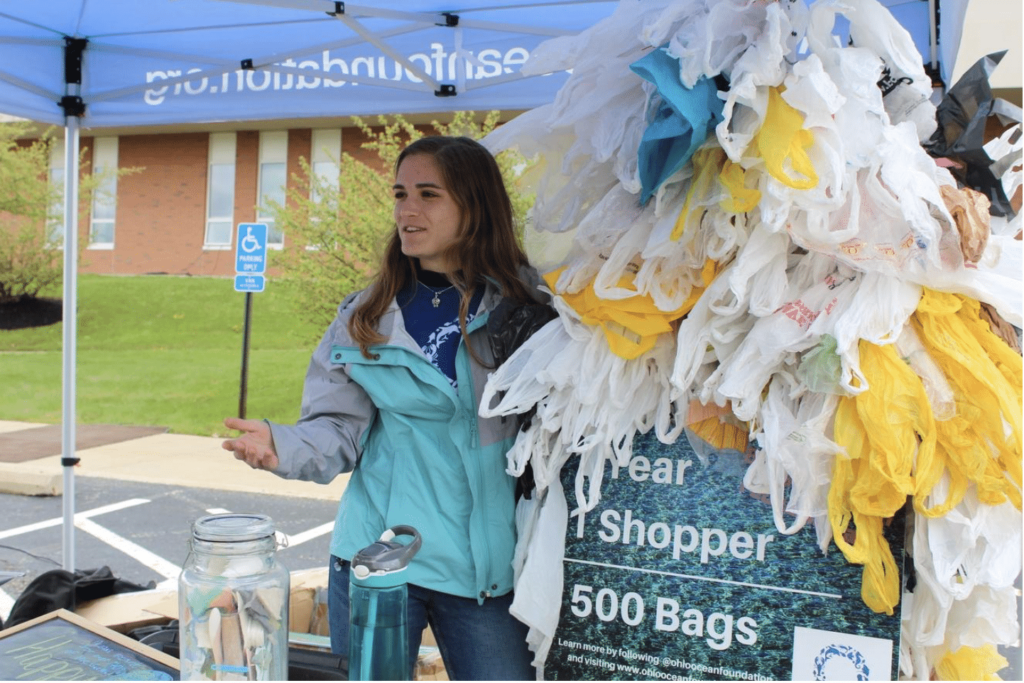
Earth Day fun
The family-friendly event had something for everyone including a nature walk around the pond and wetlands research area, planting herbs and digging for fossils in a sandpit.
Eleven-year-old Kallie Newell and her two sisters — Rubie, 3, and Irie, 5, — dug through the sand looking for tiny dinosaurs and other mock fossils. Their mother, Britny Newell, said it was their first time attending the event.
“Besides the coldness, it’s really fun,” Kallie Newell said.
Six golden retrievers greeted visitors as they wandered through the parking lot and the pathway leading to the pond.
Maria Lemmon, a retired Ohio Highway Patrol trooper and KSU alumna, brought her “golden girls” to bring smiles to those who attended the event. Children and their families were able to pet the dogs and take photos.
“The joy that I see them bring people is worth it,” Lemmon said.
Many booths addressed how residents can keep the earth clean including the Ohio Ocean Foundation.
Though the state isn’t next to the ocean, Ohioans still have an impact on ocean life because it is connected through streams and rivers, said Megan Soehnlen, a Walsh University student and intern with the Ohio Ocean Foundation.
Soehnlen stood next to the “bag monster” made of 500 plastic shopping bags as she explained how plastic bags negatively impact the earth.
Refraining from littering and picking up garbage you see outside are two ways someone can positively impact the earth and the ocean, Soehnlen said.
Some local grocery stores, such as Giant Eagle, have bins to collect plastic bags, she added. Bringing reusable bags on shopping trips can be another way to cut down on water pollution.
“We’re pretty far away from the ocean, so we may not think it effects the ocean, but it does,” Soehnlen said.
Environmentally friendly
New to the event this year, the Akron Zoo held an animal presentation where education specialist Clare Fekete talked about climate change, habitat loss, poaching and other environmental subjects.
During the 45-minute presentation, she showed attendees a box turtle, an opossum and a porcupine as she talked about each animal’s instincts and habitat.
The university, which is recognized as a Tree Campus USA by The Arbor Day Foundation, has a strong focus of being environmentally friendly, Seeton said.
Environmental studies was the regional campus’ 20th bachelor’s degree, which was added in 2017.
A greenhouse was recently constructed on campus, and students will be likely begin utilizing it in the fall, Seeton said. A community garden also grows vegetables for the Flashes Food Pantry.
“We recognize how important it is to procure our students to have knowledge of environmental issues and integrate those concepts once they reach the workplace,” Seeton said.
Amanda Cox, an environmental studies major, helped kids plant an herb in a small pot of soil as part of the Sustainable Nourishment @ Kent Stark booth. The student group had soil, compost and seeds for the kids to plant their own herb.
Children were able to choose which herb they wanted to plant including lavender, basil and cilantro.
“I’ve always been passionate about being outside and the outdoors,” Cox said. “We wanted to stir enthusiasm (in the kids) for growing their own food.”
Diane Haidet watched as her 5-year-old granddaughter, Jordyn Young, made a toad house out of a blue plastic cup and foam stickers. Haidet has been bringing her granddaughter to the annual Earth Day celebration for at least four years.
Each year there’s new activities and more for her to learn as she gets older, she said.
“It’s a nice day out, and (Kent Stark) does such a great job,” Haidet said. “She enjoys doing all the hands-on activities, and she learns a lot.”
Indoor Gardens Teaching Massillon Students New Lessons
The Herbert W. Hoover Foundation is proud to have supported the establishment of the five hydroponic gardens in Massillon City Schools. This story was originally published by the Canton Repository. The original article is available here.
Indoor hydroponic gardens, funded through a grant, have been installed in each of the district’s buildings.
MASSILLON The excitement in Karen Kortis’ kindergarten class builds as the class tortoise is taken from his enclosure and placed on the floor.
Students gather around to give their reptile friend a bite to eat.
What’s for lunch? Romaine lettuce grown by the students in their classroom at Whittier Elementary School.
Across the Massillon City Schools’ buildings, students are planting, growing and learning about vegetables.
The district received five hydroponic gardens for each of the district’s schools through a grant from the Herbert W. Hoover Foundation.
The grant provided $22,250 worth of supplies, including the indoor gardens, growing supplies such as seeds and soil for three years, training and educational lessons.
The district learned about the gardens through Katie Phibbs, co-owners of Lettuce Do Good, an indoor gardening and STEM education company that brings hydroponics into schools.
Blair said Phibbs approached other Stark County schools.
“I thought it was so cool,” she said. “The pictures were amazing. Gardening is not something that a lot of kids get a chance to experience anymore.”
Blair knew the indoor gardens would be a great learning tool for students.
“They get to learn the science behind it, harvest it and actually eat it,” Blair said. ”
The gardens have even widened students’ — and teachers’ — palates.
Growing a learning experience
At Franklin Elementary School, English as a second language teacher Sheri Dockery and her students have harvested butter lettuce, summer radishes, tomatoes, chives and kale. They also are growing basil and oregano.
They tried their hand at Cubanelle peppers, at the request of Principal Mike Medure, but didn’t have much luck with those.
Her students, many of whom have lived in the United States for only a short time, have embraced the chance to plant and grow the veggies.
With Dockery’s help, the students have planted seeds and maintain the hydroponic system, a method of growing plants without soil by using mineral nutrient solutions in a water solvent.
Hydroponics allow plants to grow up to 50 percent faster then they do in soil.
The gardens, which are housed on metal shelving units have grow lights. The students measure the nutrients in the water and replenish the water supply.
Having the garden in her room has helped students that are learning English.
“A lot of kids are visual or tactile,” Dockery said. “The whole process has been great. They are learning about gardening and the growing process while also using a lot of new vocabulary.”
Also, many of her students don’t understand some of the food items available in the United States and this is introducing them to things they may not be familiar with.
The students are less shy now that they have some knowledge, Dockery said. It gives them the ability to be able to talk to fellow classmates about something they know about.
First-grader Luis Quixan Imul said he likes to look at the different seeds while his friend Jose Lopez Gomez was excited about growing tomatoes.
The first-graders have gone beyond the indoor garden and created their own, growing lettuce in a sandwich bag — a spout house — taped to a classroom window. They placed a seed in a wet paper towel and have been tracking the progress of the seed and journaling about it.
Dockery said the students will eventually be able to take the lettuce home and plant it.
Her third-grade students are creating an eco-system.
The class has harvested their crop a few times and shared it with friends and teachers.
Dockery and her students plan to make salsa with the tomatoes and chives and sauce with the tomatoes, oregano, basil and chives.

Lettuce learn
Students in Kortis’s classroom have different opinions about what is the best part of the indoor garden.
Five-year-old Summer Marcurella said her favorite thing was planting the seeds, but her classmate Vasile Popa, 6, said eating the lettuce has been the best part.
“It’s very exciting for the kids,” Kortis said.
Learning about the life cycle of plants is part of the kindergarten curriculum, the garden enhances the lesson, she said.
Besides growing lettuce for their tortoise, the class also is growing basil, radishes, kale and chard.
When it is time to harvest all of the veggies, during a Foodie Fun Friday in Kortis’ classroom, the kindergartners will get to eat their hard work in a salad.
The garden at Washington High School is maintained by the pharmacy students, Blair said. They are learning about healthy eating and growing herbs that can be used in the medical field and homeopathic living.
The garden at the intermediate and junior high school is in the science classroom, she said.
“It’s just so cool and each teacher has had the choice of what they want to plant,” Blair added.
She hopes to continue the program beyond the three-year grant funding and possibly add new components to it down the road.
Florida’s Toxic Algae Crisis: Brain Toxins Produced by Blue-green Algae Concern Researchers
Dr. Larry Brand, a Professor in the Rosenstiel School of Marine and Atmospheric Science at the University of Miami, and Dr. David Davis, a Research Assistant Professor at the Miller School of Medicine at the University of Miami, are cited in this article from Fox 13 News. Dr. Brand and Dr. Davis are considered to be two of the leading experts on BMAA and the Herbert W. Hoover Foundation is proud to have supported their research.
Originally published by Fox 13 News. Original article available here
Blooms of cyanobacteria, also known as toxic blue-green algae, strike lakes, rivers, canals, and ponds across Florida.
The state has polluted the water with fertilizer and leaking septic tanks, which feed these blooms that turn the water green and produce some of the most powerful natural poisons on earth.
Scientists have warned exposure to the toxins can cause liver damage, and possibly brain damage. They are finding correlations to neurodegenerative disease in marine life and people. While they cannot yet say those toxins directly cause neurodegenerative disease, they say the correlations are a cause for concern and merit additional research.
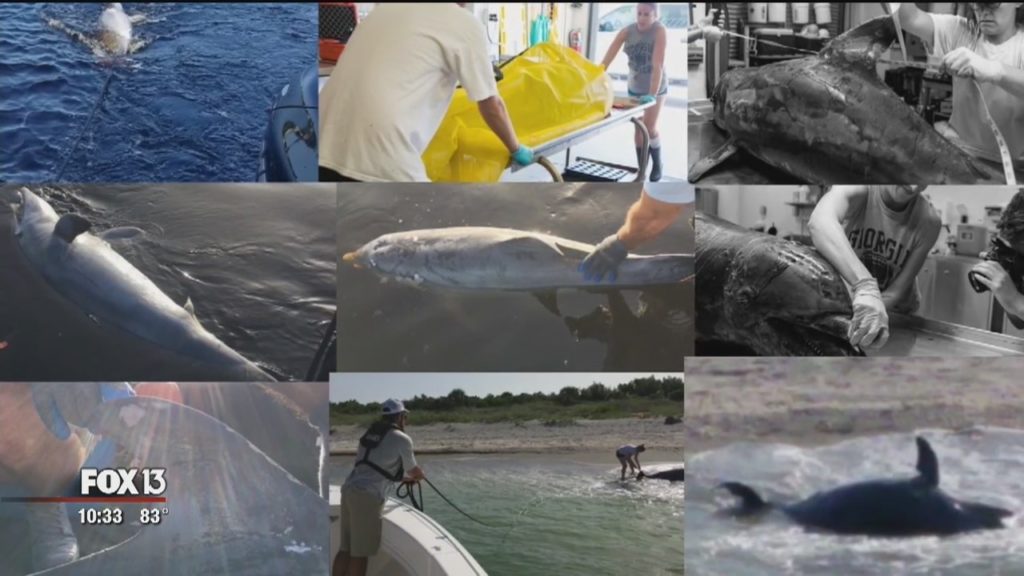
For example, the cyanobacteria emit BMAA, which is toxic to the brain and scientists now link to diseases like Alzheimer’s and ALS.
“What happens is, the BMAA causes the proteins in your brain neurons to get all tangled up, and you see the slow accumulation of tangled up proteins in your neurons until they get completely clogged and the neurons die,” said University of Miami Marine Science Professor Dr. Larry Brand. “So you just slowly develop these diseases over the timescale of 10-20 years”
Dr. Brand tested fish, crabs, and shellfish in South Florida and discovered high concentrations of BMAA in the aquatic food web. His colleagues at the University of Miami had already found it at significant levels in Floridians who had ALS and Alzheimer’s disease.
Additionally, University of Miami Professor Dr. David Davis found BMAA in the brains of dolphins found floating or beached.
Then Dr. David Davis started testing dolphins that have been turning up dead. Davis’ team tested seven dolphins found floating or beached in Florida and seven others found to our north.
Of the 14 tested dolphins, 13 “had high concentrations of BMAA in ‘their’ brains.” The one that didn’t was struck and injured by a boat.
The dolphin brains containing BMAA also showed neurodegenerative changes consistent with Alzheimer’s.
“We wanted to see if these dolphins stranded may possibly have the toxin in their system. It’s very very startling to see that amount of BMAA in dolphins. It’s roughly 1.5 times the amount we see in individuals with advanced dementia,” said Dr. Davis. “What we found in the dolphin brains are pathological hallmarks of dementia. Having both the presence of BMAA and neuropathological changes like we see with the dolphins is troubling.”
The green slime produced by cyanobacteria leaves behind a dried crust, which new research revealed sends BMAA drifting into the air.
Dr. Mike Parsons at Florida Gulf Coast University confirmed BMAA was airborne in Cape Coral through air tests. His team followed up by testing other areas. The preliminary results showed the presence of BMAA in every spot they tested, and they found it in higher concentrations the closer they got to toxic blooms in the water.
“When the cyanobacteria dries, it will almost be like a crust. I haven’t done this but it would be the equivalent of like grinding it up in your fingers and it turns into a powder, and then the winds pick up that powder,” said Dr. Parsons. “You can see it in the seawalls just this green dust. The worst case scenario would be a significant amount of Microcystin and BMAA would be getting into the air and onto the smallest filters of our air samplers.”
Parsons is expanding his research – in the present and the past. For example, 11 years ago a cluster of neurodegenerative disease cropped up near Kennedy Space Center. Engineers who were fighting ALS wondered if exposure to rocket fuel may have caused it. But new information is leading scientists to go back and look at something else.
“Were all these engineers avid sportsmen?” asked Dr. Parsons. “Were these people in the water a lot?”
Years before the rocket engineers got sick, manmade pollution fed blooms of cyanobacteria in waters around the Space Coast.
“The scary part is if the levels get elevated to a point where that exposure would overcome our natural defenses… there is justified concern by the public that the science is a little behind. We need to come up with some answers quickly,” said Parsons.
Today, Parson’s team found airborne BMAA in every spot they tested. And they found it in higher concentrations the closer they got to polluted water.
While scientists have found correlations between BMAA and neurodegenerative disease, they stress they have not established a clear cause and effect. They don’t yet know how much exposure may pose a threat to public health.
Governor DeSantis picked Dr. Parsons to serve on a new state task force to recommend changes in policy and strategy.
Potential for 100,000-Plus Jobs If We Fix Our Parks
Analysis of National Park Service data shows possible employment impact in every region
Originally published by Pew on December 6, 2018. Original article available here.
A Pew-commissioned analysis by the Cadmus Group, a consulting company, found that addressing the National Park Service’s $11.6 billion maintenance backlog would create or support nearly 110,000 infrastructure-related jobs. This number, based on fiscal year 2017 NPS data, is a reminder of the powerful economic impact of national parks.
California has the most to gain, with the potential for more than 17,000 jobs. Rural states also stand to benefit, with a possible 6,600 jobs in Wyoming. And Virginia, which has a mix of urban and rustic settings, could benefit from 9,600 jobs.
If NPS’ deferred maintenance was fully funded, communities could see construction workers repairing roads and trails, preservation experts restoring deteriorating historic sites, and engineers overhauling outdated sewer, water, and electrical systems that can threaten safety and the environment.
The analysis, “Restoring Parks, Creating Jobs: How Infrastructure Restoration in the National Park System Can Create or Support Jobs,” contains a state-by-state breakdown finding that:
- States with higher unemployment rates could gain the most.
- The job benefit is about equally split between metropolitan and nonmetropolitan areas.
This interactive map shows where potential jobs could be located as well as park visitation and visitor spending, based on fiscal 2017 NPS data. Although the maintenance backlog rose from $11.3 billion in fiscal 2016 to $11.6 billion in fiscal 2017, the job figure declined by 671 jobs, from 110,169 to 109,498. This was due to an uptick in inflation and a potential increase in the cost per job. To access a Pew-commissioned analysis and jobs interactive based on NPS fiscal 2016 data, click on this link.

Values for the U.S. territories of American Samoa, Guam, Puerto Rico, and the Virgin Islands are not shown on this map.
| Territory | Potential jobs | Current jobs supported by visitor spending | Visits | Visitor spending (millions) | Economic output (millions) |
|---|---|---|---|---|---|
| American Samoa | 9 | 51 | 69,468 | $4.0 | $5.2 |
| Guam | 46 | 273 | 384,611 | $22.0 | $28.7 |
| Puerto Rico | 263 | 850 | 1,188,780 | $68.0 | $88.7 |
| Virgin Islands | 360 | 664 | 444,838 | $50.6 | $71.7 |
Notes:
Delaware and the Northern Mariana Islands do not include any National Park System units that collect visitor spending data.
All $ figures are in millions
Source:
Cadmus Group analysis of National Park Service data from fiscal 2017; National Park Service, “2017 National Park Visitor Spending Effects” (2018), https://www.nps.gov/nature/customcf/NPS_Data_Visualization/docs/NPS_2017_Visitor_Spending_Effects.pdf.
For more information on this analysis, please see the methodology or view the Cadmus Group’s report, “Restoring Parks, Creating Jobs: How Infrastructure Restoration in the National Park System Can Create or Support Jobs” (2018), https://cadmusgroup.com/papers-reports/restoring-parks-creating-jobs/.
Coral reefs save us from flooding. We must save them from destruction | Opinion
Dr. Michael Beck’s research demonstrates coral reefs provide the United States with more than $1.8 billion in flood protection benefits annually. The Herbert W. Hoover Foundation proudly supports Dr. Beck’s expansion of this research on mangroves in south Florida.
BY MICHAEL W. BECK, MAY 15, 2019, for The Miami Herald
The 2019 Atlantic hurricane season is almost upon us; the last two hurricane seasons were devastating to Florida. The race is on to recover and build resilience ahead of the next storms. And we need to invest in one of Florida’s most valuable and underrated defenses — its reefs.
Most people have no idea how valuable coral reefs are for coastal defense. Now we do. Reefs act as submerged breakwaters, they “break” waves and dissipate their energy offshore.
Working together, the U.S. Geological Survey, The Nature Conservancy and the University of California Santa Cruz, have shown just how valuable reefs are using state-of-the-art flood-risk tools. Across the United States, reefs provide more than $1.8 billion in flood-protection benefits every year. In Florida alone, reefs provide more than $675 million in flood-protection benefits to people, property and jobs every year.
These look like general, ‘back of the envelope’ numbers. They are not. They are based on what are now the best flood-risk maps available for these coastlines. They predict flood risk at 10 meters by 10 meters, that is about one-hundredth the area of city block. So we can show not only that Florida receives benefits, we can identify specifically who may get those benefits. And we can sum those benefits up by municipality; in a 50-year storm (between a Category 4 and 5 hurricane) the coral reefs off of Miami-Fort. Lauderdale would provide more than $1.6 billion in flood protection benefits.
The bad news is that we are rapidly losing these benefits in Florida and elsewhere (and often around the densely populated areas where we need them the most). Many have predicted the end of reefs. We are not quite so pessimistic — at least not yet.
The good news is that there is evidence that reefs can recover and even adapt, particularly if we identify the resources to manage and restore them.
The better news is that by rigorously valuing these benefits we can help mobilize the public and private investments that we need for this kind of reef management. Indeed there are a number of innovative pathways for action that can completely change the scale of support for reef conservation and restoration.
First, disaster recovery funding must support the recovery of national natural defenses. The United States already has appropriated more than $100 billion to recover from hurricanes Harvey, Maria and Irma; more of those funds should go to rebuilding reefs and other natural defenses. And it appears that it may: FEMA, for the first time, is assessing damages to reefs as flood-mitigation structures.
Second, the insurance industry can support incentives for habitat conservation and restoration. They are starting to do just that by ensuring that habitats are included in industry risk models and with the first-ever trust to fund an insurance policy for coral reefs in Mexico.
Third, we must recognize and prioritize reefs as natural defenses as they are relevant to national security. Protecting and restoring reefs is relevant to state, territory and national budgets (e.g., FEMA). In Florida, reefs provide the state hundreds of millions in flood-protection services every year, and that is in addition to their many other income benefits such tourism. We should be paying the reefs back similarly to keep those benefits.
The Nature Conservancy and partners in federal, state and local governments, academia, and the private sector are working to protect and restore Florida’s coral reefs — from Martin County to Key West and the Dry Tortugas — based on sound science. The new Respect Our Reef campaign encourages protection of the reefs by the fishermen and divers who know and love them best.
And it is not just coral reefs in the United States; marshes, mangroves and oyster reefs all provide cost-effective benefits for flood reduction. And coral reefs provide benefits to people in more than 60 nations.
If we can get reef protection and restoration right in Florida, we can offer lessons learned to help protect people across the country and around the world.
Michael W. Beck is a research professor at the University of California Santa Cruz and was lead marine scientist at The Nature Conservancy.
Read the original article at: https://www.miamiherald.com/opinion/op-ed/article230442474.html#storylink=cpy
Photo by Getty Images.


